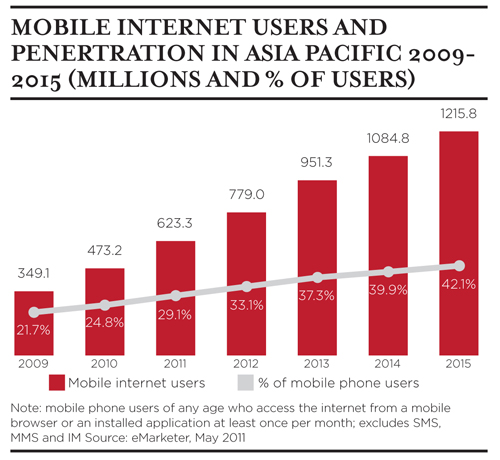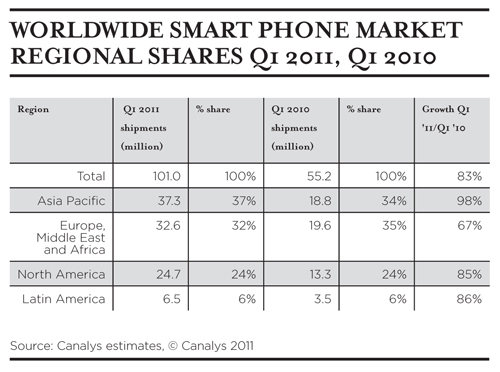Kedar Sohoni
The most important driver of change for the Asian region is growth of mobile. It opens up several opportunities for marketers and researchers to reach out to and communicate with consumers.
Impact of Moore’s Law
Moore’s law, which states that the number of transistors that can be placed on an integrated circuit doubles every two years, has continued to hold true for half a century. This has led to dramatic increases in processing power, memory capacity and other computational metrics, and has been the key driver of the bulk of the technological and social changes of the last few decades.
Due to this exponential growth, today over 2.6 billion transistors can be placed on a single IC chip. Numerous innovations have been possible because of this miniaturisation, the key one being the growth of mobile networks and devices. The maximum impact of these developments has been felt in the last decade. Simultaneously, the cost of components and computing has gone down, making the products of technological innovations affordable for the masses.
Impact on Asia
Though Asia houses 60% of the world’s population, it generates only about 25% of the world’s GDP. The continent comprises primarily developing countries, and hence the growth of infrastructure has been historically low compared to the developed world. Growth in the rates of ownership of personal computers and access to the internet has largely been driven by the western world, and most Asian economies struggled on that front until the end of the 20th century.
But the development of wireless networks and devices has changed that picture in the last decade. Quite a few countries have completely bypassed the PC/fixed broadband wave and moved directly to the wireless platform. In the western world, mobile devices are typically used as supplements to existing fixed devices like PCs. But in Asia, for numerous consumers, the mobile phone is the only device which provides them access to the internet. In fact, in some of the largest countries in the region (China, India and Indonesia, for example), the number of mobile internet users will soon exceed the number of fixed internet users. The low entry costs for mobile internet have had, and will continue to have, a significant socioeconomic and cultural impact on the developing world.
What changes are we already seeing?
For the first time in the history of mankind, we are seeing that information is becoming ubiquitous. That, in turn, is empowering people at all levels of the economy. This has changed how people communicate, how they become informed, how they are entertained, and even how they protest against non-democratic forces.
But Asia, like most other parts of the world, has been the victim of social and economic inequality. The distinction between haves and have-nots is extremely stark. When information is at a premium and available only to an elite few, that elite will use it to establish and maintain its own economic prosperity while the masses languish in poverty.
Technological advancements that help to remove this information arbitrage are our biggest hope for changing this scenario. But for the next few decades we will still have to live with this inequality, and hence marketers will have to continue with their strategy of targeting two different worlds.
What does it mean for marketers and researchers?
Mobile penetration in Asia already stands at over 65%. Moreover, Asia Pacific is now the single largest region when it comes to smartphone shipments, ahead of EMEA and North America. This has huge implications for marketers as well as researchers.
Increasingly, the mobile device is going to be the single most important source of information, entertainment and communication for the consumer. Smartphone users are already spending an average of over 2.5 hours per day on their devices, and the bulk of that time is spent on browsing, applications and entertainment. These trends are going to continue with rapid advances in smartphone technology and a corresponding reduction in device prices. Behavioural insights around device usage are going to be crucial for any marketer who wants to take advantage of the medium to the fullest, whether through advertising or by designing content that will enable the consumer to interact with a product or service in a more convenient manner.
From a research perspective, mobile devices provide the single largest opportunity to reach out to consumers in the region and obtain feedback efficiently.
Opportunities
Mobile Panels – In a short span of time, mobile research has garnered a lot of interest and has become the hot topic of discussion at many a research conference. But most of the initiatives have been concentrated in the US and Europe as an add-on to online research. The need for developing mobile technology and panels is probably higher in the developing world, including Asia, where mobile penetration is higher than PC/online penetration. The single largest opportunity for researchers is to create opt-in mobile access panels in the developing world. Given the phenomenal improvements in hardware and software, what is considered a smartphone today is going to be an entry-level phone very soon. It will provide all the functionality needed to conduct various types of multi-lingual research in a manner that is very convenient for the consumer. (The research methodologies need not be question/answer based, but could easily include any combination of voice, images, video etc.) It will also enable marketers to research consumers across all strata of society in an efficient way (a task which is very difficult today, relying as it does on time-consuming and error-prone face-to-face methodologies).
Mobile Behavioural Insights – The mobile device itself is going to be the key hub of activity for the Asian consumer. Understanding how he or she uses and interacts with the device is going to be critical for marketers. This presents two relatively untapped opportunities from a research perspective: mobile audience measurement and mobile ad effectiveness. Understanding who does what, when and why on mobile devices will provide critical insights for marketers to exploit in designing their advertising and marketing activities. At the same time, research methodologies that attempt to understand the impact of mobile advertising on brand metrics will lead to further growth of the medium.
Kedar Sohoni is president of Informate Mobile Intelligence in India
For those wishing to join ESOMAR in Vietnam for our annual Asia Pacific event, which takes place in Ho Chi Minh City on 7th – 9th April, please visit www.esomar.org/apac




